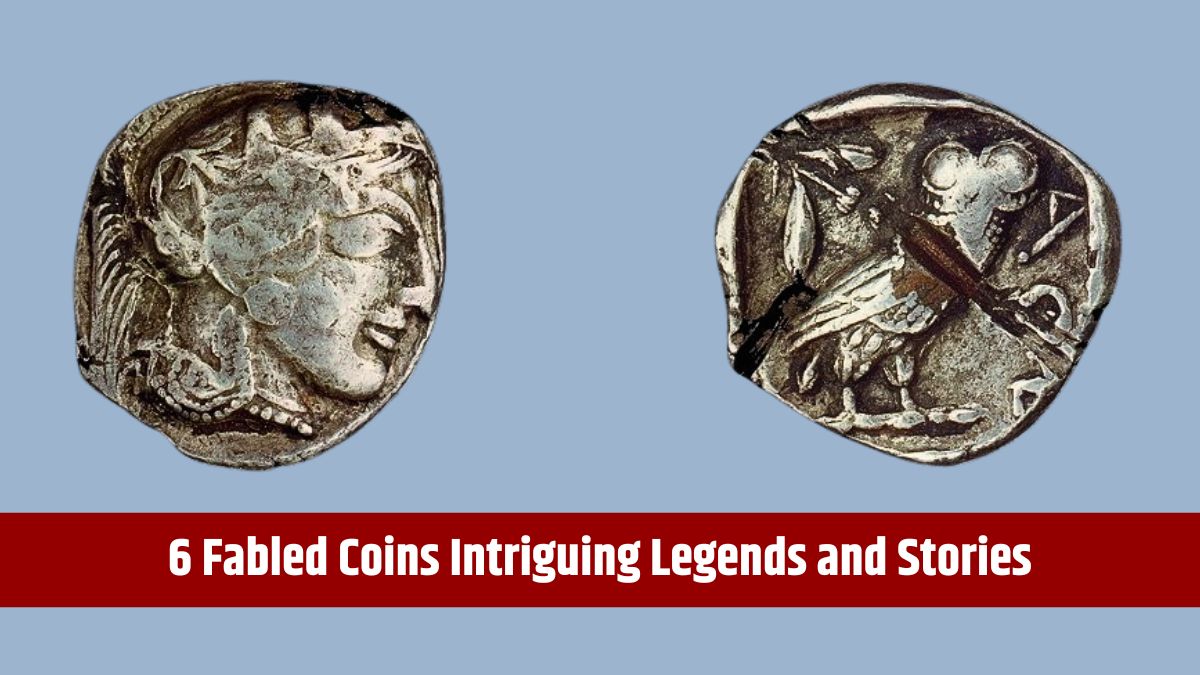Coins have long been more than simple currency. They’ve carried tales of empires, mythical blessings, and curses that transcend their economic value. Here are six legendary coins that intertwine history, myth, and intrigue, leaving an enduring legacy in the world of numismatics.
Table of Contents
Athenian Owl (c. 5th Century BCE)
The Athenian Owl, featuring an owl on one side and Athena on the other, symbolized wisdom and protection. The coin, widely used during Athens’ golden age, became associated with strategic and intellectual dominance.
The Myth:
A popular tale claims that General Themistocles carried an Owl coin at the Battle of Salamis (480 BCE), believing it granted him divine clarity. Athens’ victory over the Persian fleet cemented the coin’s reputation as a token of divine favor.
Why It Matters:
The Owl coin remains a powerful symbol of Athens’ intellectual and military prowess, celebrated as one of history’s most iconic coins.
Imperial Gold Coin of Emperor Augustus (27 BCE – 14 CE)
Augustus’ gold coins, such as the Aureus, often depicted him as a god or peacemaker. These coins were central to Roman propaganda, reinforcing his image as the stabilizer of the empire.
The Myth:
Legends suggest Augustus used these coins as “divine payments” to gods, ensuring the empire’s prosperity. Stories claimed the gold used was sacred, providing mystical protection to Rome.
Why It Matters:
These coins reflect how rulers used currency for propaganda, blending divinity and governance to legitimize their rule.
Drachma of Croesus (c. 560 BCE)
King Croesus of Lydia, renowned for his immense wealth, issued one of the first gold coins. According to legend, these coins symbolized both his prosperity and his downfall.
The Myth:
After consulting the Oracle of Delphi, Croesus misinterpreted a prophecy and attacked Persia, leading to his kingdom’s collapse. Stories claim his coins were cursed, bringing misfortune to those who sought power through greed.
Why It Matters:
The Croesus Drachma highlights the early use of coinage and its association with both wealth and hubris.
Florin of St. Peter (c. 13th Century CE)
Minted under Pope John XXII, the Florin of St. Peter was tied to Vatican wealth and the construction of St. Peter’s Basilica. It was believed to carry divine blessings, offering protection and absolution to its holder.
The Myth:
A popular tale recounts a man cured of illness by holding a Florin close to his heart, cementing the coin’s reputation as a miraculous artifact.
Why It Matters:
This coin exemplifies the intersection of religion, wealth, and superstition in medieval Europe.
Spanish Doubloon (c. 16th Century CE)
The Spanish Doubloon symbolized Spain’s colonial wealth, often associated with the riches of the New World. Pirates and sailors coveted these coins, believing they carried the fortune of the Spanish Empire.
The Myth:
Stories claim that a Doubloon in a pirate captain’s possession could command loyalty and lead its holder to buried treasure. Some sailors believed these coins had supernatural properties, guiding them to fortune.
Why It Matters:
The Doubloon represents the golden age of exploration, piracy, and colonial ambition, embodying both wealth and danger.
Blackbeard’s Gold Coin (c. 1718 CE)
Blackbeard (Edward Teach), one of history’s most infamous pirates, is said to have carried a unique gold coin as a talisman. Known as Blackbeard’s Gold Coin, it was believed to grant protection and wealth.
The Myth:
After Blackbeard’s death in 1718, the coin reportedly vanished. Legends claim it is cursed, and treasure hunters who seek it are doomed to a tragic fate.
Why It Matters:
This coin has fueled countless pirate lore and treasure hunts, symbolizing the allure and peril of lost fortunes.
These fabled coins, steeped in legend and myth, transcend their original purpose, becoming emblems of power, wealth, and mystery. Whether they brought blessings, curses, or simply stories, these coins continue to captivate imaginations across generations.
FAQs
What made the Athenian Owl coin legendary?
It symbolized wisdom and was believed to grant Athena’s favor.
Why is Augustus’ gold coin significant?
It reinforced his divine status and stabilized Roman rule.
What was the curse of Croesus’ coins?
They symbolized hubris and were believed to bring ruin to the greedy.
What powers were attributed to the Florin of St. Peter?
It was believed to grant divine blessings and miraculous healing.
Why is Blackbeard’s gold coin famous?
Legends say it protected Blackbeard and is now cursed.






